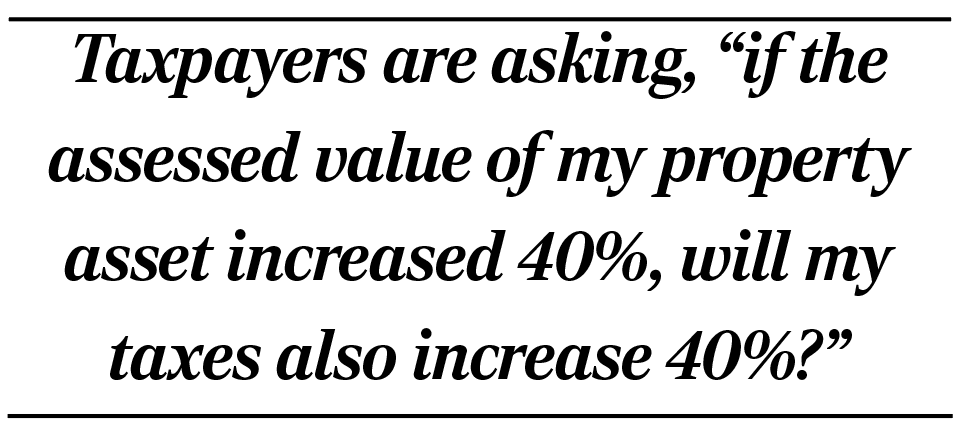OpEd by Todd Lavieri
As part of our goal to keep the town informed and provide meaningful updates from time to time, this is a follow up to my summary last month regarding property revaluations. The purpose of this letter is to continue to communicate our process and to set a range of expectations given the large swings in valuations that we have seen. We don’t have all the budget facts at this point and assumptions continue to move around since my note last month. We are just starting the budget process, and just completing the revaluation assessments. As a reminder, new assessments were mailed out to property owners in December. We saw an unprecedented increase of approximately 25% in the total value of properties in New Canaan, known as the Grand List, from $8 billion to $10 billion.
 The range of change in assessed values is wide. Some properties saw modest increases. Other homeowners have seen their property values increase more than 25%. 30 to 50% property value increases are not uncommon. In some cases, values are up even more especially if there has been an addition or major improvement. Taxpayers are asking, “if the assessed value of my property asset increased 40%, will my taxes also increase 40%?” My first response is, ‘congratulations on the increased value of your property!’ (Somehow that has been lost in the discussion). Regarding taxes, the town doesn’t require 25% more revenue this year, the percentage amount the Grand list increased. So, the answer is ‘no’, taxes will not increase 40%.
The range of change in assessed values is wide. Some properties saw modest increases. Other homeowners have seen their property values increase more than 25%. 30 to 50% property value increases are not uncommon. In some cases, values are up even more especially if there has been an addition or major improvement. Taxpayers are asking, “if the assessed value of my property asset increased 40%, will my taxes also increase 40%?” My first response is, ‘congratulations on the increased value of your property!’ (Somehow that has been lost in the discussion). Regarding taxes, the town doesn’t require 25% more revenue this year, the percentage amount the Grand list increased. So, the answer is ‘no’, taxes will not increase 40%.
At this point, we don’t know what the mill rate will be among other important budget factors that will determine our taxes. Our FY 24-25 budget season has just kicked off. The new Board of Selectman started going through the department budgets last week for the next fiscal year that starts on July 1st. They will pass a budget to the Board of Finance in late January. The Board of Finance will spend the month of February going through all the elements and details in the budget. We will then send it to the Town Council in March for their review and approval. The budget then comes back to the Board of Finance for final approval. In May we set the new mill rate that will take effect on July 1st for next year’s taxes. We still need to more deeply understand the facts on expected revenues (tax and non-tax), and understand the costs and budget requests.
As I mentioned before, property taxes are calculated through the use of a mill rate. As many of you are aware, the mill rate is applied to each $1,000 of the assessed value of the property. The current mill rate is 18.94. Now that the data and information is getting finalized, here are two examples to consider. First, a property that had an assessed value of $1,000,000. This year the property taxes would equal the current mill rate of 18.94 times 1,000 or $18,940. If the new assessed value after the revaluation is $1,100,000, and the new mill rate drops to 15.80 (still an example only at this point), then the new tax on that property will be $17,380. In this case, the property taxes will decline $1,560 or 8% even though the value increased 10%. In a second example, the same $1,000,000 assessed value increased to $1,400,000 in the new revaluation. A 40% increase in the asset value. Using the same mill rate example, the new tax would be $22,120. A $3,180 dollar tax increase to reflect the $400,000 increase in property value, or less than 1%. In this case, the property tax would go up 17%, not 40%. So, the increases or declines will be very specific to each individual property.
While we haven’t done the work yet, we do forecast and expect a substantial decrease in the mill rate. The Board of Finance hasn’t seen the submitted budgets, so we don’t know where we are starting or what the final mill rate will be. There are still many budget uncertainties, and no shortage of requests. I hesitate to put any number out there at this point, as it would only be an estimate. But I also know that residents want to plan and evaluate their individual assessments. A 3.00 point reduction in the mill rate is a reasonable estimate at this point for next year. That level of decline in the mill rate has never happened before. We will be actively working to manage the costs as we have done successfully over the prior years. Our challenges this year and next are on the non-tax revenue side. The lower mill rate next year will also have a positive impact on automobile taxes.
Once again, we expect approximately 65-70% of the budget will fund our Board of Education expenses. 8-10% for Emergency services. 6-8% for Public Works, Parks and Recreation. 8-10% for Debt expense. The rest is for Town employees and other expenses.
In fiscal years 2019 through 2023, we cut costs and delivered surpluses each year by coming in below budget on expenses and conservatively estimating revenues. Those surpluses allowed us to return money to the taxpayers each year, fund the needs of the schools and the town, and keep the amount raised by taxation nearly flat during that period. We achieved those goals even though we had contractual agreements that raised salary expenses each year for all police, fire, teachers, and school administration employees. This was an unprecedented accomplishment by our town and boards, and unmatched in Fairfield county. That work allowed us to avoid over $18 million in tax increases during that period compared with a more normal annual increase of 2.5%. Those avoided taxes are avoided forever. Our financial strength, fully funded town pensions, great schools, wonderful town assets, a healthy downtown business and restaurant district, and substantial property tax advantages compared with Westchester County, have combined to help our property values increase.
This current year we planned for a decline in non-tax revenues. Our conveyance fees for home sales for example are below prior year levels as property sales volumes have slowed. This combined with inflationary cost increases caused us to raise taxes 4% this year to meet the needs and obligations of New Canaan after being essentially flat for the prior five years. On an average, annual basis, the tax increases have been less than 1% a year over this period.
We prefer to report facts and certainties rather than ranges and estimates. But given the large swings, I felt it was important to provide at least some additional level of insight and guidance to you along the way. More to come.
Todd Lavieri, Chairman, Board of Finance

